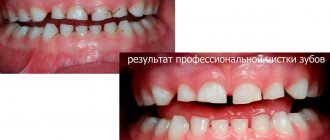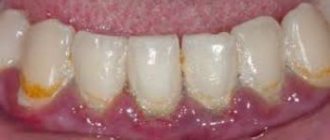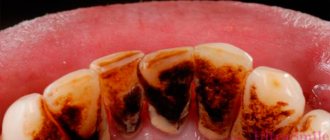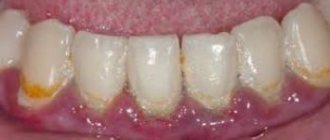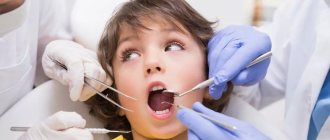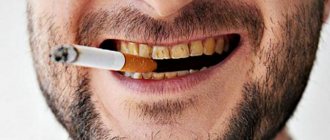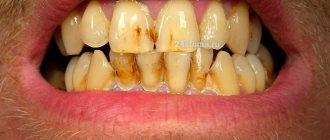Black plaque on teeth, or Priestley's plaque, occurs for various reasons. It may indicate caries, gastrointestinal problems, enamel diseases, or simply poor oral hygiene. It often appears in children aged 2-3 years. In this article we will tell you what to do if your child’s teeth become black.
In this article
- Black plaque on children's teeth: causes of formation
- A child has black teeth - what to do?
- Black teeth in children: possible complications
- Other types of plaque depending on color
- Prevention of dental plaque in children
Black plaque on teeth can appear suddenly at any age, but, according to statistics, it is 8-10 times more common in children. It looks like an uneven border of a dark color, almost black, running along all the teeth closer to the gums. In rare cases, it appears as a small spot or blackhead, often forming on the inside of the teeth.
This symptom is also called Priestley's plaque in honor of the scientist who first described it. He also named the possible reasons for its formation. The danger to health is not so much the plaque itself, which is not a pathology, but a symptom, but rather the disease that provoked its appearance.
What is Priestley's plaque?
Priestley's plaque is dark stains on children's baby teeth, which are a consequence of the activity of certain types of bacteria.
The appearance of a dark, almost black plaque on a child’s teeth can be observed at any age - both at one year old and at an older age. This is a very common occurrence on baby teeth.
As a result, due to black teeth in children, the smile becomes unattractive, and bad breath often appears.
Priestley's plaque on a child photo
However, it is not the child’s black teeth that should alert parents, but the fact that the appearance of this symptom is a signal that some kind of malfunction has occurred in the baby’s body. And to eliminate it, the first thing you need to do is consult a doctor - a pediatric dentist.
Removal methods at home
Dark formations on teeth represent hardened bacteria, food debris, salts, and inorganic compounds. They settle firmly on the enamel, so you can hardly remove them yourself. There are no ways to get rid of black plaque on teeth at home.
Folk remedies in the form of activated carbon, soda, lemon juice and abrasives are powerless here. Moreover, they can harm the oral cavity, damage mucous tissues and cause infection.
Minor discoloration can be removed with a high abrasive whitening toothpaste (RDA 100 or higher) using an ultrasonic or electric brush.
Causes of black plaque on children's teeth
There are many factors that cause black plaque on baby teeth. It is almost impossible to independently identify the cause, so you need to consult a doctor.
The most common causes of its occurrence are the following:
- Priestley's plaque in a child is the most common cause. This is due to special bacteria that produce a black pigment. It settles on the enamel, but goes away completely with age and almost never transfers to permanent teeth. This phenomenon is not dangerous to health and is considered only an aesthetic problem. Plaque can be removed at the dentist, but after a while it will still return. So you just need to wait until it goes away on its own.
- Caries. An equally common, but much more serious reason, since baby teeth are susceptible to the development of disease. They first turn yellow, black spots and spots appear, after which they turn black. The danger is that the disease will spread to permanent teeth if treatment is not started immediately.
- Dysbacteriosis. This disease can also cause problems with the digestive tract. Often occurs due to poor nutrition of the child, long-term use of antibiotics, and the presence of chronic liver or intestinal diseases.
- Excess iron. Quite often, young children are prescribed iron supplements, which often leads to the appearance of dark deposits on the teeth. At the same time, the color of the plaque can change from black to dark purple or brown.
In addition to the reasons listed, plaque can appear due to a lack of calcium, which certainly affects the teeth first. Sometimes it occurs due to impaired intestinal microflora or as a result of poor heredity - if the child’s parents had the same problem in childhood. In any case, to find out exactly the cause, it is necessary to consult a doctor in a timely manner for examination.
How can you not be afraid of the dentist from childhood?
Dial-Dent hygienists have extensive experience working with children. At the appointment, hygienists talk about how to properly brush your teeth so that caries is not a problem, and how and why the doctor treats your teeth.
A friendly atmosphere at the reception, children's songs during the procedure, gifts after visiting the doctor - all this builds a positive image of the dentist in the child. That is why, having visited the clinic several times, a six-year-old girl quite calmly goes to see a doctor she knows, knowing that there is absolutely nothing to be afraid of. This is very important because children who do not have fear of the dentist grow into adults who are not afraid to get their teeth treated on time and do not panic at the mere sight of a dental office. Unfortunately, the Dial-Dent clinic is often visited by adult patients who were so frightened by dental treatment in childhood that they can now treat their teeth only under anesthesia.
The cost of professional dental hygiene for a child is 2,740 rubles (professional teeth cleaning for children is 2,090 rubles, strengthening enamel with Tuss Mousse cream is 650 rubles).
See other works of Dial-Dent specialists here.
Diagnosis and treatment methods of Priestley plaque
The appearance of black plaque can be the result of various diseases. In order to prevent them from starting and to prevent the development of complications, it is necessary to carry out a number of diagnostic measures. Even if a small spot appears on a tooth, you should visit a doctor and undergo laser diagnostics.
If it is caries, then at an early stage of development it is much easier to cure. In addition, the doctor may prescribe additional tests: blood and urine tests. Depending on the results obtained, appropriate treatment methods are selected:
- If problems with the gastrointestinal tract are identified, it is necessary to review the child’s nutritional system. In this case, a special diet is prescribed and some foods are excluded from the diet.
- Lack of calcium or excess iron can be easily treated by taking corrective medications and eating certain foods in greater or lesser quantities.
- When identifying caries at an early stage , dental procedures such as silver plating or fluoridation can help. The doctor treats the teeth with a special solution, which helps prevent further development of the disease and wait for healthy permanent teeth.
- Common Priestley plaque can be removed by professional cleaning by a doctor. But, unfortunately, this is not a guarantee that it will not appear again after a while.
If stains or plaque on the teeth cause pain or discomfort to the child, fillings are used to preserve the teeth and eliminate discomfort.
Why do teeth darken?
When a child develops dark plaque, this indicates the proliferation of pathogenic microbes that are deposited on the tooth enamel.
Black deposits may be a sign of:
- thyroid diseases;
- diabetes mellitus;
- helminthiasis;
- dysbacteriosis;
- immunity disorders.
Dark plaque on a child’s tooth enamel appears due to dental pathologies:
- tartar;
- caries;
- mineral deficiency;
- enamel hypoplasia;
- malocclusion.
The cause of tooth discoloration may be the effect of dyes, a disorder in the intrauterine development of the child, or a genetic predisposition.
Why do you need to remove Priestley plaque?
Not all children develop dark plaque on their teeth. This is due to the fact that the body reacts differently to changes in diet, environment and other factors.
In some cases, the spots may develop gradually, and in others they form abruptly, in just a few days. At the same time, age is not important: spots can appear already in the first months after teething, although on average they form at 2 years.
There are several reasons for removing Priestley plaque in children:
- Firstly, this is an aesthetic defect that attracts unnecessary attention to the baby’s mouth.
- Secondly, bad breath due to bacterial growth.
- Thirdly, under the guise of spots, the beginnings of carious lesions of the enamel may be hidden.
You can get professional services from a dentist and advice on this issue in Moscow at the Aesculapius dental clinic. Our specialists constantly encounter similar formations in children and know very well how to deal with it.
In just one session we will restore healthy enamel color using completely safe methods. At the same time, services for removing black plaque on a child’s teeth are available inexpensively in our clinic. We cooperate with each client on individual terms and adapt to the patient’s needs.
Also, if necessary, our doctors are ready to perform qualified treatment of childhood caries and other dental procedures. Our medical complex provides a wide range of services and can help with any oral ailment.
Causes and prevention
The best way to get rid of such an unpleasant phenomenon is to prevent it in time, and for this you need to find out how it appears.
The most common reason why black plaque appears on teeth is lack of hygiene. If you don’t brush your teeth regularly, don’t remove dirt from hard-to-reach areas and neglect procedures, plaque formation is inevitable.
The remaining “unattended” bacteria accumulate in the oral cavity, first on the inside of the dental units, in the cervical area, then move to the front walls, harden, turning into tartar, and darken over time. This is why black plaque on your teeth cannot simply be removed with toothpaste or a hard brush.
At the same time, pathogenic microorganisms can penetrate deep into the tooth structure, affect the pulp and root, and cause caries, periodontal disease, gingivitis and other pathologies. For prevention, it is recommended to undergo hygienic cleaning at the dentist regularly (once every six months).
Products containing caffeine and nicotine also cause black plaque to appear on teeth. They provoke the formation of pigment plaque, change the color of the enamel, and it is quite difficult to get rid of it.
To restore the whiteness of your teeth, you will most likely have to resort to a whitening procedure.
The greatest discomfort is caused by dark plaque on the front teeth in the smile area. And the presence of bacterial deposits or stone on the enamel accelerates and intensifies the darkening process.
Other reasons include:
- excessive consumption of foods high in iron;
- use of rinses containing phenols;
- metabolic disease;
- diseases of the digestive tract;
- hormonal disbalance;
- diabetes;
- bacterial diseases of the body;
- taking certain medications;
- regular toxic exposure to metals.
If dark brown plaque on your teeth appears in the form of spots, this may be a symptom of carious lesions, in which case you should immediately consult a specialist.
How does the procedure for removing black plaque on teeth work?
Reliably and safely getting rid of dark spots on enamel is possible only with a professional dentist. Self-removal of black plaque in children using various folk remedies can lead to damage to the surface of the teeth.
Therefore, you should not self-medicate, but it is better to immediately use the services of specialists. At the Esculapius clinic we will find the root cause of the violation of the natural microflora of the mouth and eliminate the aesthetic defect from the enamel. At the same time, we use only effective methods that guarantee the highest quality results.
To treat Priestley's plaque, the Air Flow device is used, as well as ultrasound. During the procedure, a mixture of water, air and soda crystals is sprayed onto the teeth under pressure. The flow removes various types of deposits not only from the surface of the tooth, but also from the interdental spaces.
For children who do not really like brushing their teeth using the Air Flow method, soft plaque is removed with special brushes and pastes. After professional cleaning, the teeth are polished and become smooth, due to which less plaque settles on the enamel.
This procedure is available in our clinic at a reasonable cost. In addition, it is inexpensive to perform silvering of baby teeth - a preventive measure to strengthen the enamel and protect against caries, as well as other hygiene procedures. With us, your child's smile will be healthy and beautiful.
Removal techniques
So, you have found black plaque on your teeth, what should you do? The first step is to make an appointment with a dentist. Depending on the degree of damage and medical history, the doctor will select a treatment method.
The fundamental factor in choosing therapy is the causes of dark plaque on the teeth, so tests and diagnostics may be required. In some cases, consultation with a specialist may be required (in the presence of chronic diseases).
Ultrasound is recognized as an effective, proven and safe way to remove black plaque on teeth. For the procedure, a special device is used - a scaler. It emits ultrasonic vibrations and transmits them through the tip to the tooth surface. Under the influence of ultrasonic vibration, deposits are destroyed and separated from the enamel.
Ultrasonic cleaning is painless, does not cause health problems, teeth do not hurt after it and you can lead a normal lifestyle. It can be carried out for both adults and children.
A reliable result is demonstrated by the procedure using Air Flow technology. It will return your teeth to their original appearance, eliminate blackening and deposits, and restore the beauty of your smile. Can be used both in the lateral and frontal zones.
This method uses the sandblasting principle of processing sand of a certain dispersion. A mixture of water, air and abrasive particles is applied to the tooth surface under high pressure. The enamel is polished, becomes smooth and is cleared of pigment and solid particles.
These were the basic tips on how to remove black plaque on teeth, but it is wiser to still use preventive measures and not lead to clinical treatment.
Possible complications after plaque formation in children
It is strictly not recommended to ignore the problem and wait until it goes away on its own (unless diagnostics have been carried out and the absence of diseases has been revealed).
Black plaque on a child’s teeth can be not only an aesthetic problem, but also a symptom of more serious and health-threatening diseases, which in their advanced form will require expensive and difficult treatment.
In addition, they can cause complications, which will also lead to unpleasant consequences:
- Inflammation and bleeding of the gums when eating or brushing teeth.
- The risk of developing various dental diseases increases, in particular caries, stomatitis and periodontal disease.
- Dense dark plaque quite often turns into tartar, so even with safe Priestley plaque, professional teeth cleaning is recommended at least once every six months.
- The appearance of bad breath, accompanied by toothache and a feeling of discomfort.
If the progression of plaque is caused by the lack of treatment for caries, the disease begins to fill deeper cavities, which leads to the development of pulpitis, periodontitis and other related diseases. As a result, baby teeth may need to be removed, which is highly undesirable.
A child has black teeth - what to do?
It is dangerous to ignore this symptom, since the pathology that caused it will develop further. In addition, plaque is a favorable environment for the active proliferation of bacteria, therefore increasing the risk of developing caries.
Diagnostics can take place in several stages. First, the dentist will examine the child's teeth for caries. If caries is excluded, examination using laser equipment and radiography are prescribed. You may need to consult with doctors of other specialties. In cases where no pathology is detected, plaque is simply removed during an ultrasound procedure.
Treatment depends on the cause of the black plaque. If a child is diagnosed with intestinal problems, he is prescribed medications that restore the balance of microflora and his diet is adjusted. If there is a lack of calcium and iron in the body, an appropriate diet is prescribed, including foods containing essential microelements. If caries develops, remineralization or filling is performed. It all depends on the stage of the carious lesion.
Disease prevention
Preventive measures to prevent the development of dental diseases and the formation of plaque should be applied from the moment the baby first starts teething. The risk of unpleasant problems occurring can be significantly reduced by the following simple measures:
- Gentle oral care . Infants up to one year old can clean their gums with a cotton pad soaked in a decoction of chamomile, string, oak bark or sage. Special silicone attachments are also widely popular, which adults put on their fingers and thus clean the baby’s oral cavity. From the age of two, children must be taught to brush their teeth with a brush and toothpaste, and it is also advisable to rinse the mouth after each meal.
- Proper nutrition. This does not imply following any diets, but the child’s nutritional system should be designed in such a way as to limit his intake of sweets, sugar, confectionery and increase the consumption of healthy natural products. Sweets from the store are an excellent substitute for candied fruits, fruits and dried fruits.
- Timely abandonment of pacifiers and bottles. With prolonged use of a bottle or pacifier, an incorrect bite develops, dependence on accessories appears, and a black plaque forms, which in dentistry is called “bottle caries.” You should not delay in weaning your child off devices that he no longer needs.
- Maintaining the immune system. It is important to ensure that even in winter, the child has enough vitamins to maintain healthy teeth and the body as a whole.
By following these simple recommendations, you will ensure your child’s dental health and the beauty of a child’s smile.
Prevention is better than cure
Parents should think about healthy teeth and a snow-white smile for their children from a very early age:
- Start care when the first baby tooth appears. Using dental wipes, a silicone fingertip with a brush, you should brush your baby’s teeth and massage the gums.
- Teach children from the age of 2 to use a brush correctly and brush their teeth twice a day, rinse their mouth after eating.
- Starting from the age of one, you should visit pediatric dentistry with your child twice a year.
- Provide a balanced diet with sufficient vitamins and minerals.
- Wean your child off pacifiers and bottles in a timely manner to form a correct bite.
- Introduce solid foods into your diet to naturally cleanse tooth enamel.
- It is imperative to treat caries of baby teeth.
Such preventive measures and compliance with the rules of oral hygiene will help avoid the appearance of black teeth in a child.
Enamel hypoplasia
We are talking about severe thinning, partial or complete absence of enamel. Hypoplasia is a disease that manifests itself not only in the form of whitish spots, but also grooves and depressions on the tooth surface. It can be triggered by various factors:
- infectious diseases during pregnancy;
- Rh conflict between mother and fetus;
- premature birth;
- birth injury;
- taking certain illicit drugs by a pregnant woman;
- disturbances in the functioning of the endocrine, nervous systems or gastrointestinal tract.
The pathology is accompanied by increased sensitivity of teeth to irritants and caries.
Causes of yellow teeth
Most often, children's teeth turn yellow due to parental neglect. They must understand that they need to take care of their oral cavity from the moment the first tooth emerges. In advanced conditions, plaque removal will be required. The causes of yellowness may be hidden in acquired diseases. The color of children's crowns is negatively affected by jaundice, as brown spots appear. Also, a dark shade may appear due to problematic digestion.
As a result of mechanical damage, the enamel may crack or chip. And, as a result, yellow spots appear. The pathology is caused by hypoplasia of the enamel layer, under which there is yellowish dentin. In this case, the teeth are already yellow at the time of eruption. Factors in the development of hypoplasia include pathologies of the mother during pregnancy. After all, organs are laid down and mineralized in the womb. Precipitating factors include maternal infections and toxicosis, birth trauma, and prematurity of the infant.
Rare diseases can also be to blame for yellowness. We are talking about dentinogenesis imperfecta and amelogenesis. The first pathology develops with a congenital disorder of the dentin development process. And the second disease is associated with improper formation of the enamel layer. Most often, such anomalies are characteristic of girls. Their treatment is complex and must be started immediately after the units appear.
Eating junk food
Often, yellow teeth in a child are the result of food dyes. This situation is caused by frequent consumption of pumpkin and carrot juice. Orange dyes penetrate microcracks very easily, causing the crown to turn yellowish. Coloring vegetables, berries and fruits, for example, beets or blueberries, also work. Their bright color stays on little teeth!
It is necessary to remember the negative impact on acid units. It could be a too sour apple or applesauce, orange or lemon juice. They can cause acid necrosis. The cracks that appear are immediately filled with dyes and the crowns become dark. It should be noted that iron also affects the shade of enamel. Most often, this situation is typical for well water in rural areas where there are no filters.
A separate conversation about sweets, baked goods, candies, chewing gum with sugar. Particles of these products that remain in the mouth provide a favorable environment for bacteria and pathogenic microorganisms that settle in plaque. Here it is appropriate to remember that the most harmful food is its increased dose!
Poor oral hygiene
Children who do not know how to brush their teeth are most at risk of developing unsightly stains. Therefore, it is important to teach your child how to properly use a brush and toothpaste. It is good if parents keep this process under control. Well, when the situation is difficult, you need to have your teeth cleaned of yellow plaque by a professional hygienist. Only daily procedures at home will consolidate the results and prolong the effect.
- The first incisors are wiped with a soft bristle brush after any feeding.
- When the baby learns to hold the hygiene instrument himself, he needs to be taught the rules of brushing his teeth.
- The brush and paste are selected according to age. The dentist will provide invaluable assistance with this.
- Parents should monitor the cleaning process until 8-10 years of age.
- Children with orthodontic elements are subject to special monitoring. Monthly professional cleaning is the norm for these guys.
With improper care, unsightly plaque, stones and plaques appear. This worsens the child’s appearance and increases the risk of developing dental diseases. We are talking about caries, gingivitis, periodontal disease, and pathologies of the ENT organs.
Taking medications
Some medications cause enamel discoloration. This group of antibiotics primarily includes tetracycline and amoxicillin. If taken by a pregnant woman, it usually causes her baby's teeth to turn yellow. Often these drugs are prescribed to children themselves, even up to one year old. Their frequent use almost always contributes to darkening of the enamel. What to do? In such a situation, hygienic cleaning of the oral cavity is indicated. Professional dentistry will correct the unsightly condition. “Tetracycline teeth” can be whitened using modern technologies. Of course, such procedures should be prescribed to the child by a doctor.
Genetic predisposition
It has long been proven that the color of units is strongly influenced by genetics. If parents have dull teeth, then it is not surprising that the same yellow spots will appear on the child’s teeth. True, the factor of heredity does not occur often, so it cannot be called determining. But you shouldn’t write off genetics either. Today, more and more medical scientists are proving its importance. When diagnosing and developing a treatment program, the dentist must take into account the genetic line so that the therapy is effective.
Poor maternal nutrition during pregnancy
During the period of bearing a child, a woman must eat properly and nutritiously in order to receive valuable microelements and vitamins from food. If the diet is unbalanced, the fetus does not develop fully. From birth, such babies have thinned enamel due to the fact that even in the womb there was a deficiency of nutrients, especially calcium, vitamin and fluoride. Brown dentin will be visible through the thin layer. This causes yellow plaque on the child’s teeth. Therefore, a prerequisite for the proper development of the fetus is the rational nutrition of its mother.
To prevent the child’s teeth from deteriorating, the mother must have enough calcium and fluoride. A powerful source of calcium is sesame. The seed must be thoroughly crushed or chewed to release the beneficial trace element. Don't forget about bananas, salmon, broccoli and olive oil. To replenish fluoride reserves, you need to include avocados, carrots, cucumbers, and dates in your diet.
Treatment at the dentist's office
A modern dental clinic offers a wide range of services, including procedures for cleaning teeth from black plaque and their subsequent strengthening. Treatment for dental diseases directly depends on the pathology that provoked the appearance of dark deposits.
Caries treatment is carried out using classical or innovative techniques. All manipulations are performed using anesthesia and do not cause pain to the child.
Diseases such as enamel hypoplasia, tartar and mineral deficiency require mainly preventive procedures, which include oral hygiene and strengthening teeth.
Malocclusion leads to damage to teeth, wear and thinning of enamel and discoloration of teeth. Treatment of bite pathologies involves wearing special orthodontic structures.
Prevention
All pathologies require preventive manipulations that are aimed directly at removing plaque and strengthening the affected tooth enamel.
Preventive procedures.
- Professional teeth cleaning.
- Remineralization of enamel.
- Fluoridation of teeth.
The dentist consults with parents and the child to teach proper oral hygiene. The specialist also gives recommendations on the choice of dental care products. For general strengthening of the body and dental tissues in particular, a vitamin-mineral complex is prescribed.

